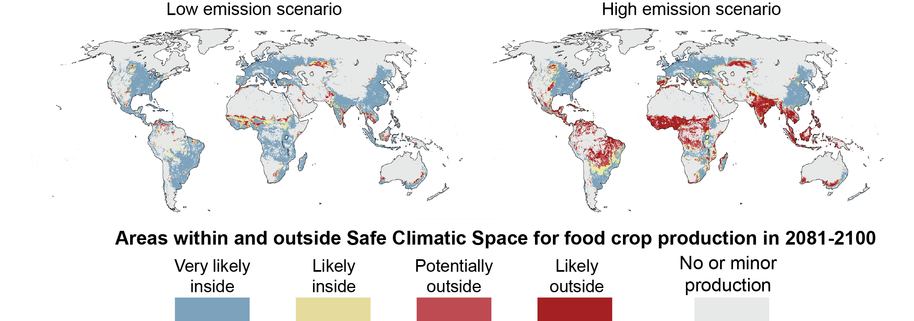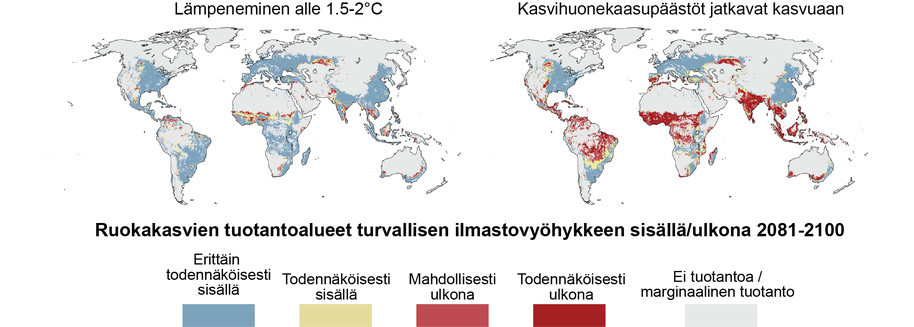Finland
May 14, 2021
New estimates show that if greenhouse gases continue growing at current rates, large regions at risk of being pushed into climate conditions in which no food is grown today.

Areas within and outside Safe Climatic Space for food production 2081-2100
Climate change is known to negatively affect agriculture and livestock, but there has been little scientific knowledge on which regions of the planet would be touched or what the biggest risks may be. New research led by Aalto University assesses just how global food production will be affected if greenhouse gas emissions are left uncut. The study is published in the prestigious journal One Earth on Friday 14 May.
'Our research shows that rapid, out-of-control growth of greenhouse gas emissions may, by the end of the century, lead to more than a third of current global food production falling into conditions in which no food is produced today - that is, out of safe climatic space,' explains Matti Kummu, professor of global water and food issues at Aalto University.
According to the study, this scenario is likely to occur if carbon dioxide emissions continue growing at current rates. In the study, the researchers define the concept of safe climatic space as those areas where 95% of crop production currently takes place, thanks to a combination of three climate factors, rainfall, temperature and aridity.
'The good news is that only a fraction of food production would face as-of-yet unseen conditions if we collectively reduce emissions, so that warming would be limited to 1.5 to 2 degrees Celsius,' says Kummu.
Changes in rainfall and aridity as well as the warming climate are especially threatening to food production in South and Southeast Asia as well as the Sahel region of Africa. These are also areas that lack the capacity to adapt to changing conditions.
'Food production as we know it developed under a fairly stable climate, during a period of slow warming that followed the last ice age. The continuous growth of greenhouse gas emissions may create new conditions, and food crop and livestock production just won't have enough time to adapt,' says Doctoral Candidate Matias Heino, the other main author of the publication.
Two future scenarios for climate change were used in the study: one in which carbon dioxide emissions are cut radically, limiting global warming to 1.5-2 degrees Celsius, and another in which emissions continue growing unhalted.
The researchers assessed how climate change would affect 27 of the most important food crops and seven different livestock, accounting for societies' varying capacities to adapt to changes. The results show that threats affect countries and continents in different ways; in 52 of the 177 countries studied, the entire food production would remain in the safe climatic space in the future. These include Finland and most other European countries.
Already vulnerable countries such as Benin, Cambodia, Ghana, Guinea-Bissau, Guyana and Suriname will be hit hard if no changes are made; up to 95 percent of current food production would fall outside of safe climatic space. Alarmingly, these nations also have significantly less capacity to adapt to changes brought on by climate change when compared to rich Western countries. In all, 20% of the world's crop production and 18% of livestock production under threat are located in countries with low resilience to adapt to changes.
If carbon dioxide emissions are brought under control, the researchers estimate that the world's largest climatic zone of today - the boreal forest, which stretches across northern North America, Russia and Europe - would shrink from its current 18.0 to 14.8 million square kilometres by 2100. Should we not be able to cut emissions, only roughly 8 million square kilometres of the vast forest would remain. The change would be even more dramatic in North America: in 2000, the zone covered approximately 6.7 million square kilometres - by 2090 it may shrink to one-third.
Arctic tundra would be even worse off: it is estimated to disappear completely if climate change is not reined in. At the same time, the tropical dry forest and tropical desert zones are estimated to grow.
'If we let emissions grow, the increase in desert areas is especially troubling because in these conditions barely anything can grow without irrigation. By the end of this century, we could see more than 4 million square kilometres of new desert around the globe,' Kummu says.
While the study is the first to take a holistic look at the climatic conditions where food is grown today and how climate change will affect these areas in coming decades, its take-home message is by no means unique: the world needs urgent action.
'We need to mitigate climate change and, at the same time, boost the resilience of our food systems and societies - we cannot leave the vulnerable behind. Food production must be sustainable,' says Heino.
The article Climate change risks to push one-third of global food production outside Safe Climatic Space can be read on: https://doi.org/10.1016/j.oneear.2021.04.017
Tuore tutkimus: Ilmastonmuutos uhkaa jopa kolmannesta maailman ruoantuotannosta
Suomi on ruoantuotannon suhteen turvallisella ilmastoalueella myös tulevaisuudessa, mutta luontoon ja ekosysteemeihin ilmastonmuutos voi vaikuttaa rajusti. Jos hiilidioksidipäästöjen kasvu jatkuu entisellään, uhkaa havumetsävyöhyke kadota Suomesta lähes kokonaan vuoteen 2100 mennessä.

Karttakuva kahden eri skenaarion vaikutuksesta. Kuva: Tutkimusryhmä
Ilmastonmuutoksen tiedetään vaikuttavan haitallisesti sekä ravintokasveihin että tuotantoeläimiin, mutta tutkittua tietoa siitä, mihin suurimmat vaikutukset kohdistuvat, on ollut niukasti saatavilla.
Aalto-yliopiston professori Matti Kummun johtaman tutkijaryhmän julkaisu arvostetussa One Earth -tiedelehdessä arvioi millaisissa ilmasto-olosuhteissa ruokaa viljellään tulevaisuudessa.
“Kasvihuonekaasujen nopea ja hallitsematon kasvu saattaa johtaa siihen, että vuosisadan loppuun mennessä yli kolmasosa maailman nykyisestä ravinnontuotannosta ajautuu ulos turvalliselta ilmastoalueelta olosuhteisiin, joista ihmiskunnalla ei ole kokemusta. Tämä on todennäköistä, mikäli hiilidioksidipäästöt jatkavat kasvuaan”, Vesi- ja ympäristötekniikan tutkimusryhmässä työskentelevä Kummu sanoo.
Sademäärän muutokset, kuivuus ja ilmaston lämpeneminen uhkaavat erityisesti Etelä- ja Kaakkois-Aasian sekä Afrikan poikki ulottuvan Sahelin alueen ruoantuotantoa. Kummankin alueen kyky sopeutua muuttuviin kasvuolosuhteisiin on jo nyt alhainen.
”Nykyinen ravinnontuotanto on kehittynyt pitkän ajan kuluessa melko vakaissa ilmasto-olosuhteissa sen jälkeen, kun ilmasto alkoi hiljalleen lämmetä edellisen jääkauden jälkeen. Kasvihuonekaasujen jatkuva ja nopea kasvu voi tulevaisuudessa luoda olosuhteet, joihin ravintokasvien viljely ja karjankasvatus eivät ehdi tai kykene sopeutua”, sanoo artikkelin toinen pääkirjoittaja, tohtorikoulutettava Matias Heino.
Turvallinen ilmastoalue
Turvallinen ilmastoalue on tutkijoiden tähän tutkimukseen kehittämä uusi käsite. Sen avulla he pystyivät arvioimaan tärkeimpien ilmastotekijöiden – sademäärän, lämpötilan ja kuivuuden – muutosta ruoantuotantoalueilla.
Tutkijat käyttivät tutkimuksessaan kahta ilmastonmuutoksen skenaariota: toisessa hiilidioksidipäästöjä vähennetään niin että lämpeneminen pysyy alle kahdessa asteessa ja toisessa päästöt jatkavat kasvuaan. He arvioivat ilmastonmuutoksen vaikutuksia 27 tärkeimmän ravintokasvin viljelyssä ja seitsemän eri tuotantoeläimen kasvatuksessa huomioiden samalla yhteiskuntien kyvyn sopeutua muutokseen.
Uhat kohdistuvat eri maihin ja maanosiin eri tavoin. Tutkimuksessa oli mukana 177 maata, joista 52:ssa ravinnontuotanto säilyisi tulevaisuudessakin ilmastollisesti turvallisella alueella. Näiden joukossa ovat kaikki Euroopan maat, kuten Suomi ja muut Pohjoismaat.
Pahimmassa tilanteessa olisivat Benin, Kambodža, Ghana, Guinea-Bissau, Guyana ja Suriname, joissa jopa 95 prosenttia ruoantuotannosta putoaisi turvallisen ilmastoalueen ulkopuolelle. Näissä maissa myös yhteiskunnan mahdollisuus sopeutua muutokseen on merkittävästi pienempi kuin esimerkiksi Suomessa.
Ilmastonmuutos vaikuttaa hyvin eri tavoin eri kasvillisuusvyöhykkeisiin
Jos hiilidioksidipäästöt saadaan kuriin, tutkijat arvioivat havumetsävyöhykkeen alan kutistuvan 18,0 miljoonasta neliökilometristä 14,8 miljoonaan neliökilometriin vuoteen 2100 mennessä. Mikäli päästöjä ei saada kuriin, vyöhyke kutistuisi noin 8 miljoonaan neliökilometriin, ja Suomesta havumetsävyöhyke katoaisi lähes kokonaan.
Tundralle käy vielä huonommin: sen arvioidaan katoavan maailmasta käytännössä kokonaan, mikäli nykyistä ilmastonmuutosta ei saada hallintaan. Vastaavasti trooppisten lehtimetsäalueiden ja trooppisten aavikoiden määrän ennustetaan kasvavan
”Erityisen huolestuttavaa on aavikkoalueiden lisääntyminen maailmanlaajuisesti 60 miljoonasta neliökilometristä jopa 64 miljoonaan neliökilometriin. Tämä tarkoittaa monen tärkeän ekosysteemin katoamista sekä ruoantuotannon vaikeutumista monilla alueilla”, Kummu sanoo.
”Tutkimuksemme vahvistaa aiemmista tutkimuksista saadun tiedon, jonka mukaan maapallon lämpeneminen yli 1.5-2 asteen johtaa laajoihin ja dramaattisiin muutoksiin ympäristössä, ekosysteemeissä ja siten myös maailman ravinnontuotannossa”, Heino muistuttaa.
Linkki artikkeliin (avoimesti luettavissa): https://doi.org/10.1016/j.oneear.2021.04.017